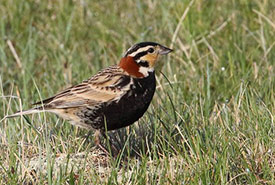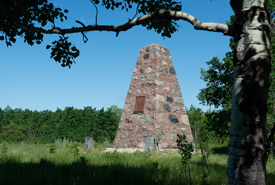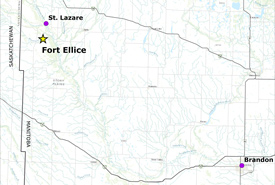Fort Ellice: A Hidden Gem

Chestnut-collared longspur (Photo by Christian Artuso, iNaturalist, CC BY-NC-ND 4.0)
The Fort Ellice project is truly awe-inspiring. Fort Ellice is a species-rich area comprised of mixed-grass prairie, aspen forests, riverbank and floodplain forests, sandhill prairie and sand dunes, wetlands, streams, freshwater springs and willow shrublands. The property is home to more than one rare and distinctive habitat. Calcareous fens are peat-accumulating wetlands that depend on a constant supply of groundwater rich in minerals. Tufa mounds, also known as “petrifying springs,” are geological formations created by a deposit from springs or streams of groundwater. Both are important habitat for a diversity of species, and both can be found here.
Many species of provincial and national conservation concern occur on the lands surrounding Fort Ellice. The majority of these species are found only in sandhill prairie/mixed-grass prairie habitat, including chestnut-collared longspur, loggerhead shrike, Sprague's pipit and Baird’s sparrow, and depend upon the unique grassland habitat for survival.
Large mammals, like elk, moose and Canada lynx, roam the property.

Fort Ellice cairn (Photo by T. Fricke)
A place for people to connect throughout history
The Fort Ellice project lies along the Carlton Trail. This historical pathway is responsible for the western expansion of Canada where, during the 18th and 19th century, several trading post forts were constructed. The fort, after which this property is named, was originally established as a Hudson’s Bay Company trading post in 1831. Today, nature has reclaimed the land and only a subtle reminder of the fort is left. Its preservation, however, is an important cultural and historical contribution to Manitoba.
The Nature Conservancy of Canada (NCC) recognizes the rich Indigenous history of the Fort Ellice project and respects and seeks to protect the cultural integrity as well as the plants and wildlife found here. To learn more about Fort Ellice's connection to the signing of Treaty Four, we encourage you to watch this video, The History of Fort Ellice and Treaty Four from the Treaty Relations Commission of Manitoba.
NCC partners with Parkwest School Division and the Waywayseecappo Off-Campus School to achieve tangible conservation on the Fort Ellice project. Participating students are trained as “citizen scientists” through workshops and actual field work, helping them connect with the land.
Grazing is an important land management tool on the Fort Ellice property. NCC’s collaboration with farmers and other landowners makes it possible to develop effective land management programs. These programs, including grazing, benefit both the local livestock industry and the native grasslands.
Visiting today
Fort Ellice is home to a beautiful community interpretive site, making it more than an ecological gem. It's also a place to explore the area’s nature, history, culture, and local economy.
We are proud to partner with community members who worked for a long time to create a space which continues to build on connections to the land. In NCC's short time as caregivers of the Fort Ellice site, this has been a place where ceremonies have been held, students have come to learn, and scientists and archeologists have come to study it’s many wonders. It’s a favourite of almost every staff, partner and donor who has ever been here.
As a gathering place for many generations, it is inspiring to know that future generations also have the opportunity to connect this place with their personal history. Fort Ellice is a place to strengthen your sense of self and community through a love of nature and a desire to protect the natural world around you.
We encourage you to explore the interpretive site, and in the near future, the extended nature trail which will take you along the top of the escarpment.
A virtual tour
You can experience Fort Ellice without leaving the comfort of your home, too. Explore this stunning landscape through Google Trekker, a backpack-mounted 360-degree camera that uses the same technology as Google Street View.
Breathtaking natural beauty
More than 90 per cent of Manitoba’s prairie grasslands have been lost. In fact, grasslands are one of the most endangered ecosystems in the world, and they continue to disappear at an alarming rate. It is estimated that we lose an additional 59,489 hectares every year.
Surrounded by the 15,783-hectare Ellice/Archie Community Pasture, Fort Ellice emcompasses one of the last large intact expanses of native prairie grassland in Manitoba.

Fort Ellice Context Map (by NCC)
Grasslands,long been synonymous with Canada’s Prairie provinces, buffer our waterways, sequester carbon, provide habitat for pollinators and are the foundation of sustainable ranching economies in rural communities.
With its breathtaking natural beauty enhanced by the Assiniboine River and Beaver Creek valleys, Fort Ellice is a national treasure.
Grasslands are essential
Prairie grasslands like those on Fort Ellice impact your daily life, even if you’ve never visited them. They absorb and store billions of tonnes of carbon, provide protection from flooding and drought, and help purify our water.
Prairie grasslands are essential for humans, but also for the numerous species that rely on the ecosystem to survive.
You can make a difference for grasslands, by donating today.





